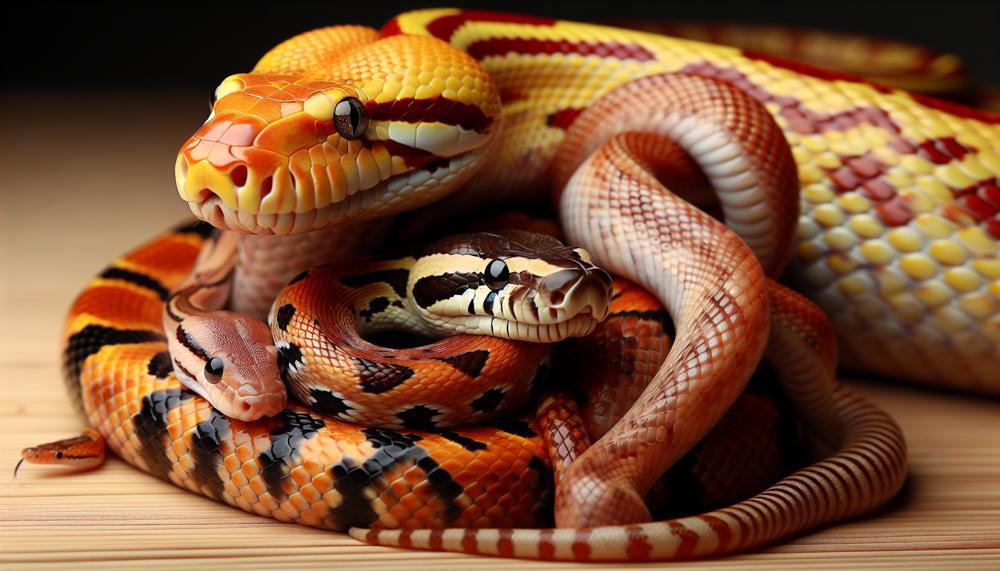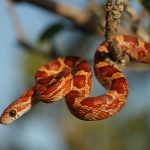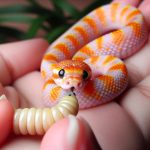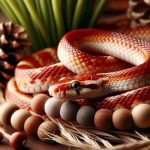Corn snakes are a beloved choice for pet owners, thanks to their vibrant colors and docile nature. But there’s more to these slithering companions than meets the eye. Did you know that corn snakes are also skilled constrictors? Yes, you read that right. These seemingly harmless reptiles have a powerful hunting technique that sets them apart from other snake species.
Their method is simple yet effective: using their muscular bodies, corn snakes wrap themselves around their prey and squeeze with incredible force. This cuts off the animal’s blood flow and suffocates it, making for an easy meal.
Don’t underestimate the strength of these creatures; they can constrict animals much larger than themselves, including rodents, birds, and even other snakes.
But don’t worry; this behavior is completely natural for corn snakes and helps them survive in the wild. As pets, they do not pose any threat to humans as they are not large enough to constrict us. Plus, with proper handling and care, these gentle creatures make fascinating companions.
So if you’re considering adding a corn snake to your family or are simply curious about their unique abilities, keep reading.
In this blog post, we’ll delve deeper into the world of corn snakes as constrictors and uncover some fascinating facts about these incredible creatures. Prepare to be amazed.
Contents
Corn Snakes Are Constrictors
Corn snakes are skilled hunters, using the method of constriction to capture and kill their prey. As constrictors, these snakes rely on their powerful muscles to wrap around their prey and squeeze until it suffocates or experiences cardiac arrest. This method is particularly effective when hunting small animals like mice, rats, birds, and eggs.
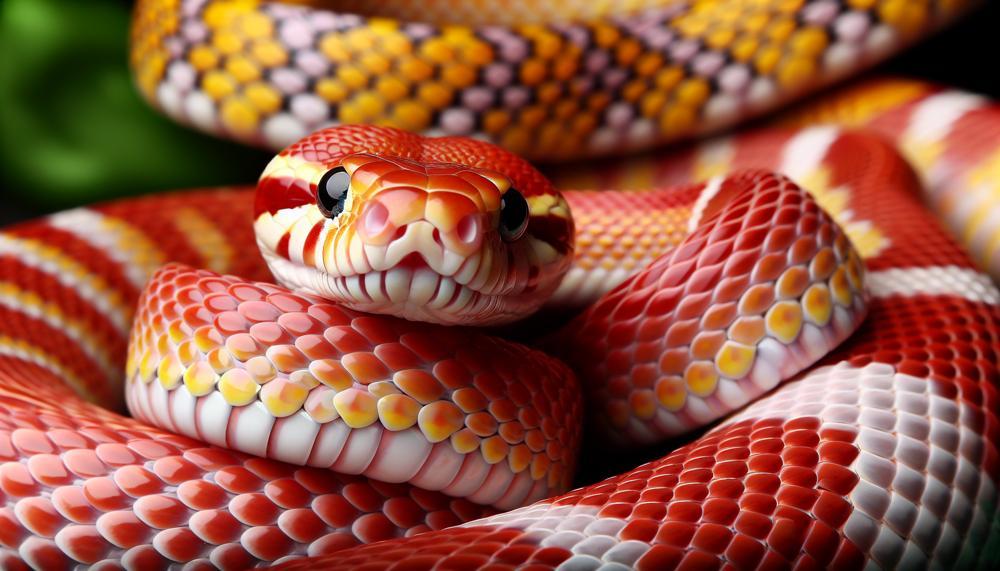
Unlike other snakes, corn snakes do not possess the venom to immobilize their prey, so their survival depends on their ability to constrict. Additionally, corn snakes have sharp teeth that they use to bite and hold onto their prey while coiling around it.
Once the prey is deceased, they will consume it whole. This hunting and killing technique is innate for corn snakes and allows them to thrive in their natural habitat as well as in captivity.
However, it’s crucial for owners to understand that these are carnivorous reptiles with specific dietary needs and behaviors that must be respected.
What Do Corn Snakes Eat?
Corn snakes have a diverse and varied diet, consisting mainly of small furry creatures such as mice, rats, squirrels, birds, and lizards in their natural habitat. However, as pets, they are typically fed rodents like mice or rats. The size of the prey depends on the snake’s age and size, with larger snakes consuming larger prey.
In the wild, corn snakes use a range of hunting techniques to capture their food, including ambush and constriction. However, due to their narrow heads and limited stomach capacity, they are unable to consume large prey items.
In captivity, it is crucial to provide a balanced and appropriate diet for corn snakes to ensure their overall health and well-being. Juveniles should be fed once every 5-7 days, while adults can be fed every 10–14 days. The size of the prey should be about one-and-a half times the width of the snake’s head. It is highly recommended to feed pre-killed prey instead of live ones for safety reasons.
If a corn snake refuses to eat, it could be an indication of incorrect enclosure conditions or prey size. Seeking veterinary advice is highly recommended if the issue persists.
To keep corn snakes mentally stimulated and content in captivity, it is essential to provide a varied diet and imitate their natural hunting behaviors.
How Often Do You Need to Feed Corn Snakes?
When it comes to feeding your corn snake, the recommended schedule is to feed hatchlings once every 5-7 days, while adults should be fed once every 7–10 days. Consistency is key to maintaining proper digestion, a healthy body weight, and a strong immune system for your pet snake.
But how often do you really need to feed your corn snake? The answer may not be as simple as it seems. While the recommended schedule is a good starting point, there are other factors to consider when determining the frequency of feeding for your corn snake.
Firstly, it’s important to understand that every snake is unique and may have different dietary needs. Some snakes may require more frequent feedings due to their size or metabolism, while others may need less. Observing your snake’s behavior and body condition can help you determine if they need to be fed more or less often.
Another factor to consider is the size of the prey being fed. Feeding larger prey less frequently can provide a more balanced and nutritious meal for your corn snake. On the other hand, smaller prey may require more frequent feedings to meet their nutritional needs.
In addition, the time of year can also play a role in your corn snake’s feeding schedule.
During colder months, snakes tend to slow down and may require less food than during warmer months, when they are more active.
Can Corn Snakes Constrict Humans?
No, corn snakes are not capable of causing harm to humans due to their small size and lack of strength. Although they are constrictors and use their muscles to subdue prey, they do not constrict humans for food or protection.
While bites from corn snakes may result in slight discomfort, they are generally not painful or harmful to humans. In fact, corn snakes are a common choice for pets among people of all ages due to their gentle demeanor and minimal upkeep needs.
Corn snakes are non-venomous reptiles that can be found throughout the southeastern United States. They can reach lengths of up to six feet, but most average around three to four feet. Despite their fearsome appearance, they are actually quite harmless and are known for their docile behavior.
In fact, many people keep them as pets due to their low maintenance requirements and friendly nature.
While corn snakes may use constriction as a means of catching prey, this behavior is not present in their interactions with humans. They are not strong enough to constrict and overpower a human and they do not see humans as a potential food source.
As a result, people of all ages can safely keep these snakes as pets and they pose no threat to humans.
In contrast to larger constrictor species such as pythons and boas, corn snakes have a much lower risk of causing harm to humans. This makes them an ideal choice for those looking for a reptile pet without the potential danger associated with larger species.
Are Corn Snakes Good Pets?
Corn snakes have many desirable characteristics that make them easy and enjoyable pets to care for.
One of the most appealing features of corn snakes is their size. These reptiles typically grow to be 3-5 feet in length, making them small and manageable for owners. This also means they require less space and can comfortably live in a vivarium or enclosure, making them suitable for smaller living spaces.
In terms of habitat requirements, corn snakes are low-maintenance pets. Their natural habitats are easy to replicate and require minimal upkeep, making them ideal for beginners who may not have much experience caring for reptiles.
Corn snakes are also known for their docile nature. Unlike some other types of snakes, corn snakes are the least aggressive and rarely bite unless they feel threatened or are hungry. This makes them great pets for those who enjoy handling their reptiles, as they can be handled regularly without becoming agitated.
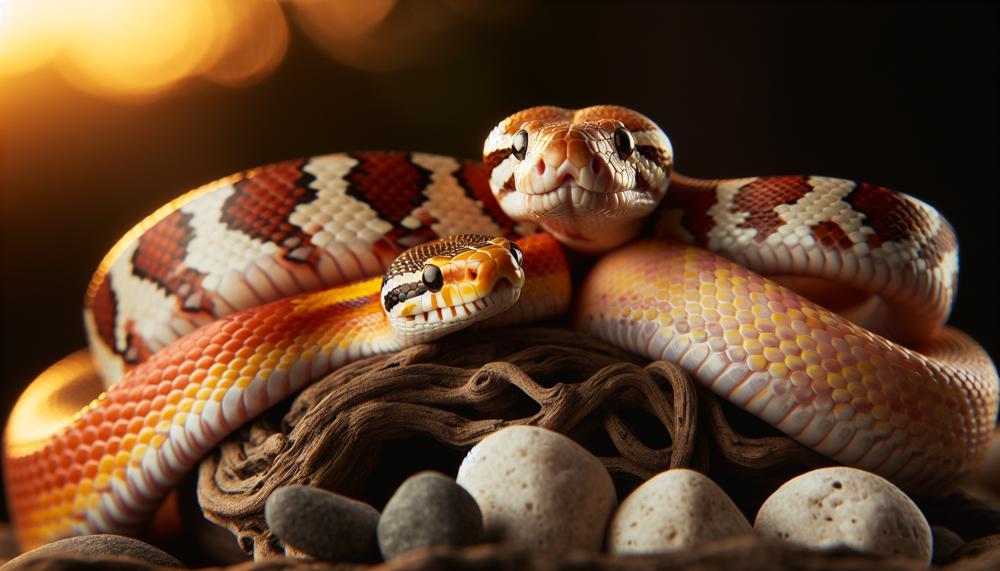
In addition to being easy to handle, corn snakes also have a high sense of smell and can become accustomed to their owner’s scent. This allows for potential bonding between owner and pet, adding a personal touch to the relationship.
Furthermore, corn snakes have a relatively active nature and graceful movements that can be entertaining to watch. This provides constant entertainment for their owners and allows for consistent interaction with their pets.
Corn snakes also come in a wide variety of colors and patterns, making them aesthetically pleasing pets. Popular morphs include Albino, Okeetees, Snow, Black, and Lavender corn snakes, providing options for owners who want a unique-looking pet.
When properly cared for, corn snakes can live up to 20 years in captivity. This means they can provide long-term companionship for their owners, forming a strong bond over the years.
Unlike some other snake species, corn snakes lay eggs instead of giving birth to live young. This makes the breeding process less complicated for owners, adding to the simplicity of caring for these pets.
Lastly, it is not recommended to keep multiple corn snakes together, as they may become aggressive towards each other. This allows for individual ownership and the opportunity for a strong bond between owner and pet.
Conclusion
In summary, corn snakes are more than just colorful and gentle companions.
These slithering creatures possess a unique hunting technique that sets them apart from other snake species: they are skilled constrictors. Using their muscular bodies, they wrap themselves around their prey and exert immense pressure, making for an effortless meal.
This behavior is completely natural for corn snakes and poses no threat to humans as pets. As we have discovered in this blog post, corn snakes use constriction to hunt small animals in the wild and require a varied diet consisting of rodents, birds, and eggs in captivity.
With their low maintenance requirements, calm demeanor, and lengthy lifespan, corn snakes have captured the hearts of reptile enthusiasts worldwide.

